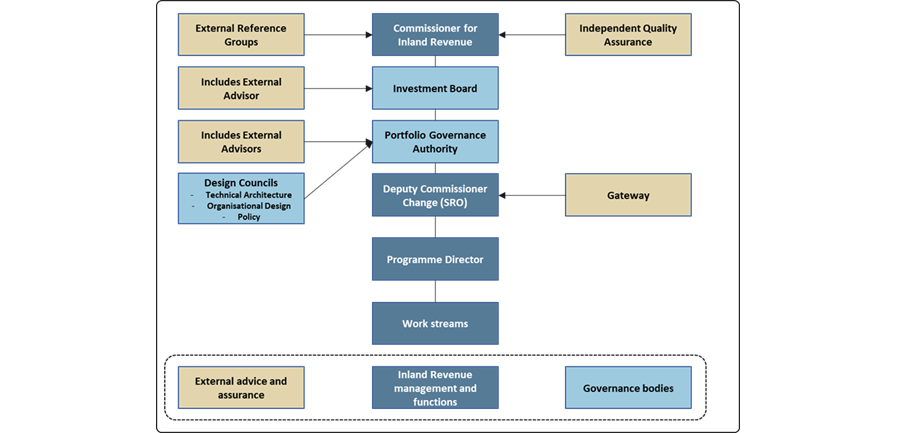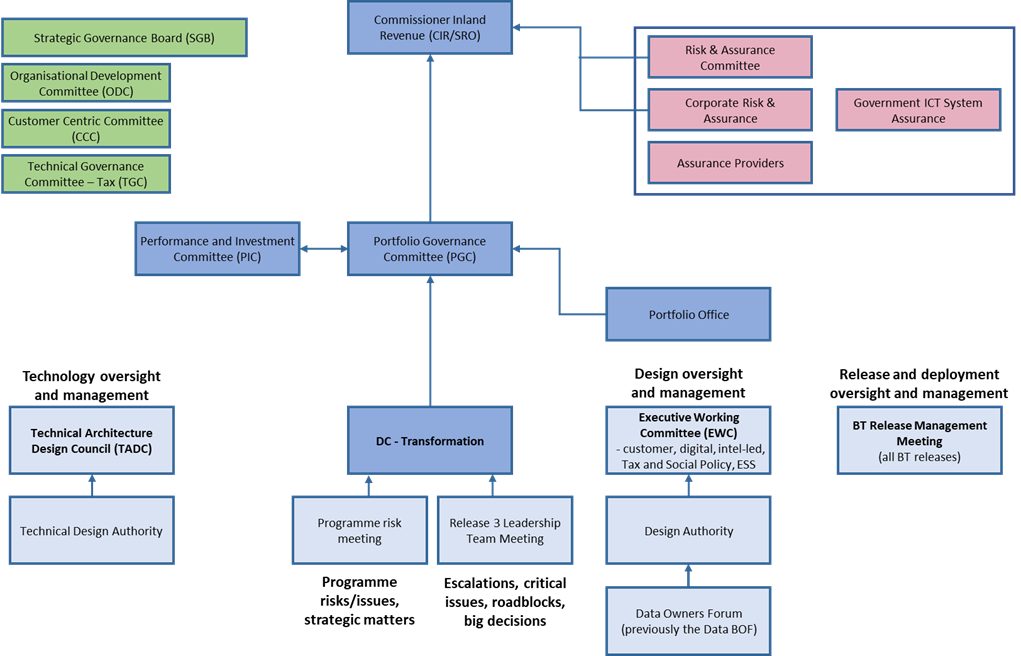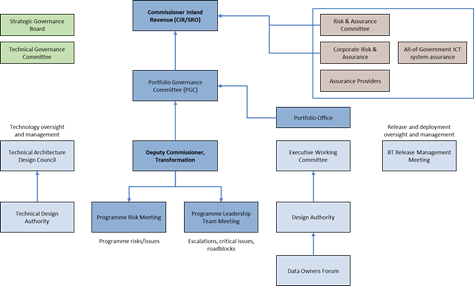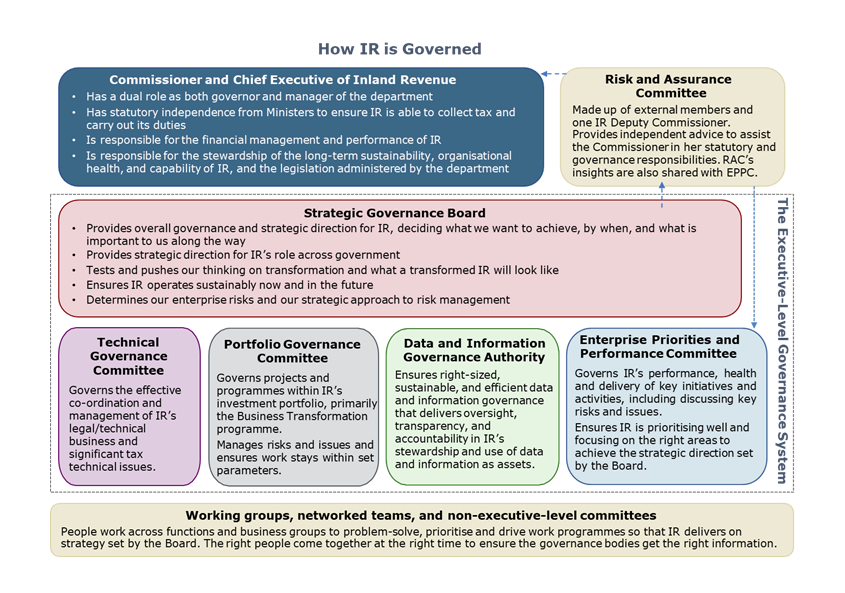Strong and effective governance was instrumental in establishing the discipline needed to successfully complete our transformation programme.
We adjusted governance arrangements as we went, ensuring they kept up to date with what was needed and reflected the different phases of the programme. A robust governance system meant there was never any doubt about who had authority to make decisions.
Some of our governance forums included external advisors, who played an important role in challenging our thinking.
The Strategic Governance Board gave approval to start each stage of the transformation, and the Portfolio Governance Board was accountable for making sure it happened on time and within budget.
We reviewed our senior management and organisational-level governance arrangements to ensure Business Transformation was successfully managed. This included the Commissioner’s responsibility to complete our transformation programme.
The principles of our governance structure
We established new organisational leadership, management and governance arrangements that supported clear accountability and strongly focused on organisational change. We also put in place independent assurance arrangements to provide confidence that Inland Revenue was successfully delivering the programme. These included:
- opportunities for Government to regularly monitor programme progress
- broad engagement with customers, other agencies and third parties to ensure the changes we proposed met their needs, were appropriate and gave the private-sector more chances to get involved
- ensuring we had the skills to manage large change programmes and the procurement of service and product suppliers
- bringing on a design and implementation partner who had proven experience in transformation programmes of this scale and complexity.
The programme focused strongly on process, project management and disciplines. This included a large focus on planning, reporting, risk management and documentation.
We also focused on completing each stage on time and did not allow dates to shift without good reason, and not just because work had not been finished. Over time this led to a cultural shift – where people became more accurate in their planning and accountable for meeting their commitments.
Changing governance along the way
There were 5 changes to our governance structure from 2013-2021 and each change was included as an addendum to the programme business case.
The Commissioner led the Investment Board, which had a complete view of change across the organisation, including Business Transformation.
We established 3 new governance forums to focus on business performance, investment, and strategy. All the Executive Leadership Team were members of these new governance forums.

Our governance structures continued to be responsive and adaptive over the life of the programme to ensure they remained fit for purpose. By 2015, the programme had begun to mobilise for delivery and as such, required a structure which could facilitate delivery at pace. At this point, therefore, the key features of the governance structure for the programme were:
- The Senior Responsible Officer was the Deputy Commissioner, Change.
- The Commissioner chaired the Investment Board, which ensured that Inland Revenue’s investment portfolio lined up with its strategic direction.
- The Deputy Commissioner, Change chaired the Portfolio Governance Authority, which ensured that programmes and projects met their objectives. The programme provided a status update to PGA (Portfolio Governance Authority) each month.
- External advisors sat on both the Investment Board and the Portfolio Governance Authority.
- The Design Council's members represented a wide range of business functions and were chaired by tier 2 or 3 managers. The councils ensured that solutions met business needs and were an important communication channel between the programme and the rest of Inland Revenue.
Inland Revenue governance bodies, including the Risk and Assurance Committee, supplied wider support and assurance.

In July 2017, we reviewed our governance arrangements ahead of the implementation of Release 2.
Prior to this we created the role of Deputy Commissioner of Transformation, replacing Deputy Commissioner of Change. The existing Deputy Commissioner of Change became the Deputy Commissioner of Transformation, with the Commissioner taking on the role of Senior Responsible Officer.
This decision was made for several reasons:
- The Programme Director resigned leaving a significant gap, ahead of the first release.
- This resulted in the Deputy Commissioner of Change taking a more active role in the programme’s operation which necessitated a 100% focus on the transformation.
- Subsequently, the change function which previously reported to the Deputy Commissioner of Change, was moved to the Chief Technology Officer.
- As the Deputy Commissioner Change became the Deputy Commissioner for Transformation, it was appropriate for the Chief Executive Officer to assume the role of Senior Responsible Officer for the transformation programme.
By October 2018, the governance arrangements consisted of a Strategic Governance Board with 5 committees.
- Performance and investment
- Customer-centric
- Organisation development
- Technical governance
- Portfolio governance
Transformation provided regular updates to both the Portfolio Governance Committee and Performance and Investment Committee.
We also made changes to design and integration with the replacement of the Design Integration Forum with the Design Authority, and the Technical Design Integration Forum with the Technical Design Authority.

From February 2020, we made some changes to streamline our governance system and set ourselves up for a smooth transition to a post transformation world.
The governance structures were adjusted to govern the final activities of the programme.
The Performance and Investment, Organisation Development and Customer-Centric committees were formally closed in August 2020. The remaining governance bodies made any governance decisions that would have been made at these committees.

Our governance arrangements have continued to evolve to ensure they remain fit for purpose. Two new executive-level governance bodies have been established:
- The Enterprise Priorities and Performance Committee (EPPC) was established in September 2020. EPPC governs our performance, health and delivery of key initiatives and activities, and ensures the focus is on the right areas to achieve the strategic direction set by the Strategic Governance Board.
- The Data and Information Governance Authority (DIGA) became part of our executive-level governance system in August 2021. DIGA ensures we have transparent and accountable governance arrangements that provide oversight of how we manage and use data.


